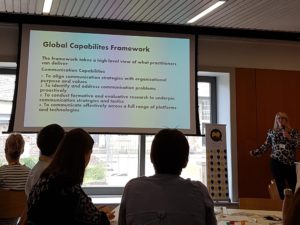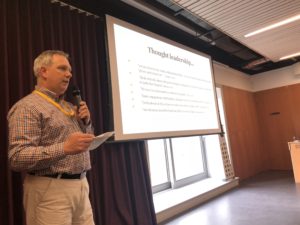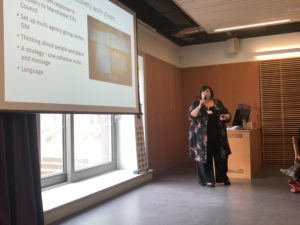How PRFest has been and gone already, is a different topic, but I know how the two days passed so quickly…
Both days were jam-packed full of great content. The programme was and can never been 100% for everyone, both days, every year. What the programme is designed to do, is help you learn, think differently and guide you to becoming a practitioner of the future.
The initial feedback has been fantastic and a more comprehensive survey will be sent to attendees and speakers later next week.
- 95% of attendees voted the venue 4 or 5/5
- 85% of attendees voted the catering 4 or 5/5
- Over 95% of attendees voted the atmosphere 4 or 5/5
- 100% of attendees voted the speakers 4 or 5/5
- 100% of attendees voted the event an overall 4, 4.5 or 5/5
I’m going to split the summary blog into two posts, for the purposes of covering off two different days.
Day one was a day for thinking and reflection.

#1
I kicked off the festival by talking about some recent stats from the CIPR’s State of the Industry report (2017/18) – it all pointed to practitioners not identifying important skills and knowledge to develop.
I highlighted the launch of the Global Capabilities Framework and urged everyone to get to know it.
I underlined the responsibility of every practitioner to look after and invest in their own professional development. Don’t be lazy. Don’t assume. Plan your CPD and commit to it. You’ll reap the rewards.
#2
Matt Cartmell, PRCA’s Deputy Director General was the first speaker up and set a serious tone with his ethics case study of Bell Pottinger’s expulsion and the demise of the UK operation. Some may argue too serious to kick off a high-energy event, but by asking Matt to speak first, I felt I was sending a message. Ethics is top on the professional agenda and it should be a priority in how we operate.
#3
Ella Minty quickly opened our eyes by a simple visual. Simple until we understood that the meaning of the visual was where Coca Cola went wrong many years ago. In international countries, things are different. Not just people and culture, but even how they read! Having worked in 40 countries, she was well placed to talk about the things to consider before you move into new markets and countries.
#4
As SEO becomes a much bigger and opportunistic part of public relations, Andy Barr did a sterling job, showing us how link building could do wonders for campaigns and how it can impact the bottomline. It was also good to hear him dispel myths and he added his usual fun to his presentation showing us some widgets his team had created as part of campaigns and the results they can deliver.
#5
When someone asks you what you think internal communication is, what would you say? Jenni Field’s definition: “Everything that gets said and shared inside an organisation. As a function its role is to curate, enable and advise on best practise for organisations to communicate effectively, efficiently and in an engaging way.”
Jenni used the VMA Group and Gatehouse reports to outline where the industry is at, but they told a different story.
The focus however over the next 12 months looks like this:
- Communicating strategy, values and purpose
- Improving digital channels
- Enhancing leadership communication
- Supporting a change and/or transformation programme
- Developing/refreshing an internal comms strategy
This presentation led nicely into a new piece of research which Padraig McKeon had done in Ireland, looking specifically at senior practitioner skills for the future.
#6

Padraig’s research found that traditional skills were top priority for most, and there’s still resilience to looking beyond that and driving change through digital and management skills.
We need strategic thinking to be the number one skill and priority for everyone. Yes, we can’t ALL be the strategic ones as people do have to deliver, but for senior practitioners, we need to be moving with the times and the strategic teaching can be taught to more junior practitioners over time, who one day will be senior.
Padraig also hit the nail on the head that strategic thinking has to come from listening and understanding. He points out that academics and practice have to work together more closely to bring substance to representation.

#7
The next presentation was a continuation from last year’s presentation by Amanda Coleman, which was the first presentation on the Manchester Attack, only a matter of weeks after the event. Jen Green, who Amanda works so closely with, talked about the road to recovery after such a huge blow to a city.
People were at the heart of everything they did. Even having difficult conversations to say no, preserving the privacy of those affected, giving the appropriate time to recognise what happened and work together to start to heal the community. You may have seen the bees across the city of Manchester?
A second standing ovation at PRFest. Amanda in 2017 and Jen this year. Such an emotional talk to deliver but by sharing learnings and best practice, it has immensely helped other practitioners across the country.
#8
The final session of the day was about using an idea from another industry and applying it to anything. What I would have described as ‘design thinking’, Laura Richards led a workshop around human-led design.
Simply put, it’s an approach to problem solving. Who wouldn’t benefit from knowing that, right?
As public relations is all about people and human-led design is about people, it’s the perfect combination.
The three phases, inspiration, ideation and implementation were described and Laura set everyone to work in small groups.
And of course…
To wrap up the day, we finished slightly ahead of time and we agreed we’d head to the pub!
For all speaker slides from the first day, click here.
